Where Patrick Mahomes Gets His Cool

Each morning, Jake Parker wakes up in Midland, Texas, in a remote trailer a few hundred feet from a hole in the ground. Parker takes his cues from the engineers who design the oil wells and oversee every phase of construction, from groundbreaking to production. “They know a little bit more about the process than we do,” Parker says. The 22-year-old has one specific yet important job: As a wireline operator, he handles the precision tool needed to make alterations deep in the well. If an engineer calls for a perforation in the well wall 15,000 feet into the earth, Parker builds an explosive strong enough to reduce a man to a puddle of bone and sinew, connects it to the end of a cable, lowers it into the hole and sets off the charge. There’s plenty of free time at the well; plenty of waiting around for the moment you’re needed. On Sundays when he can’t make it into town, he streams NFL games on his phone through a sketchy WiFi connection. By any means necessary, he will see his old friend and Whitehouse High teammate Patrick Mahomes take snaps for the Kansas City Chiefs. “I watch every game, any way I have to get it done,” Parker says. He’s part of a group text of guys from Tyler, Texas, including Mahomes and his closest friends, who do the same. Last Monday night in Denver, while the NFL world whooped guffawed at a second-year quarterback on 3rd-and-seven switching the ball from his right to his left hand at a dead sprint to complete an improbable pass for a critical first down, the guys in the group text reached back into the archives.
You remember when Pat hit that left-handed home run?
Yes! He called it!
The group text remembers.
They were 14, and Mahomes’ and Parker’s Tyler East all-star little league team was playing Tyler West. Patrick’s father, Pat, the former Major League Baseball pitcher, was one of the managers. East was having its way with West, and with the game out of reach, Patrick took a moment before heading to the on-deck circle and made an announcement to the dugout. Patrick had never been a switch-hitter (or thrower for that matter). He’d only tooled around with a left-handed swing in boredom-driven moments at practice. “We had a big lead like usual and he got up and said, ‘I’m going to go up there left-handed and hit a home run,’” Parker says. “He would mess around in the cage now and then but nobody expected him to hit a home run in a game.”
So they giggled, and their teammate stepped to the plate, stuck his right foot in front of him and zoned in. The first pitch was low and away. Ball one. The second pitch met aluminum alloy and went soaring over the right-centerfield fence. He actually did it. On a lark, Patrick Mahomes called his shot and hit a homer left-handed.
In Denver, in 2018, Patrick Mahomes’ new teammates had a very different reaction to his most recent left-handed feat. Chiefs edge rusher Justin Houston, all 260 pounds of him, barreled into the locker room in a fever after a 27-23 come-from-behind win. Before the media was allowed to enter, and before coach Andy Reid gave a victory speech, Houston jogged around the room, stepping between equipment bags, helmets and discarded shoulder pads, impersonating his new hero. The veteran of 94 regular-season games and five NFL playoff games cocked a big left hand back and threw mock spirals to whoever would catch them, an homage to a man and a moment.
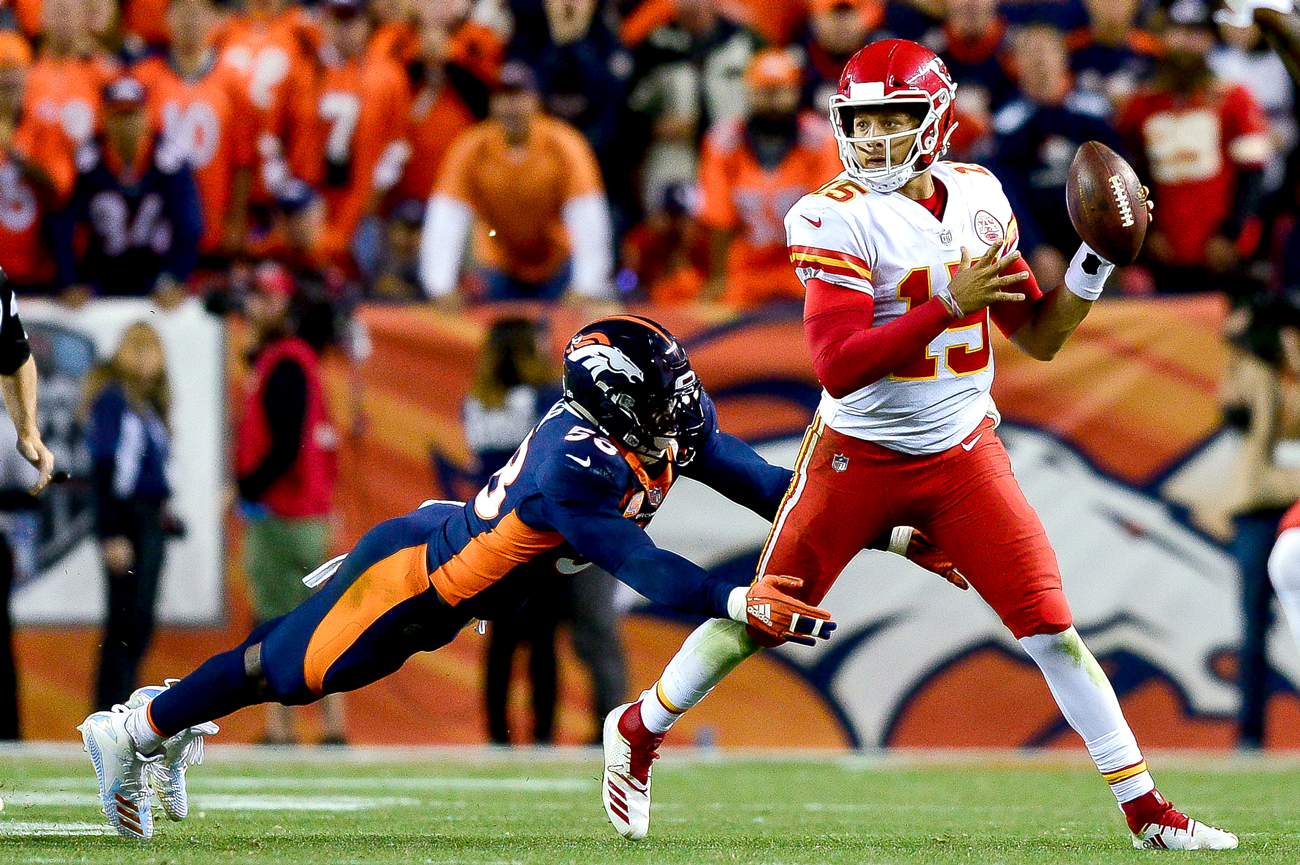
About an hour earlier, Broncos defensive coordinator Joe Woods had his defense in the perfect scheme for the scenario; the blitz was so well-disguised that Chiefs center Mitch Morse sent the protection to the wrong side. Mahomes had a beat to tuck tail and sprint to the sideline, then he switched hands and chucked the ball to Tyreek Hill in stride, as Von Miller dragged Mahomes down from behind. That the play happened in front of the Chiefs bench was icing on the cake; the defensive starters and offensive reserves acted as though they’d witnessed LeBron James hit a buzzer-beater from half court with a hand in his face.
“It showed how cold-blooded he is. He has ice in his veins,” Houston said once things calmed down in the visitors locker room. “To be that confident in your left hand, on the run, fourth quarter? You’re a cold-blooded guy to do some s--- like that.” Just then, the coach walked by and caught the pass-rusher’s gaze. Reid put a finger to his mouth and whispered, “Shh, shh, shh,” as he headed to the bus.
Quiet down, Justin. For the love of God, let’s not jinx this.
In four short weeks, Mahomes, the 10th overall pick in the 2017 NFL draft, has delivered the kind of performances that garner MVP consideration; in fact, oddsmakers across the board installed him as the early MVP favorite heading into Week 5. His 1,200 passing yards and 14 touchdowns (with zero interceptions) lead the NFL, and the Chiefs are 4-0 headed into a Sunday showdown in Kansas City with Jacksonville’s No. 1-ranked defense.
Mahomes has become the reluctant face of a juggernaut offense years in the making. In 2013, John Dorsey and Andy Reid found field-stretching tight end Travis Kelce in the third round. They drafted center Mitch Morse in the second round in 2015 and wide receiver Hill in the fifth round in 2016. Mitchell Schwartz, the ironman right tackle, was added in free agency in 2016. Then Mahomes and running back Kareem Hunt were picked in 2017, months before Dorsey would be replaced with current GM Brett Veach. Now, in his first year as a starter, Mahomes is at the center of a fine-tuned, highly specialized offense, alternately utilizing a trend-setting quick-passing game to get the ball in the hands of playmakers, and throwing deep balls on a dime 40 to 60 yards downfield.
Ask the boys back home, coaching high school ball in Tyler or pumping oil in Midland, whether they thought any of this was possible when they were going home early in the 5A state playoffs, and they’ll honestly tell you: No. Mahomes always excelled at any sport he played, but he was never the kind of prodigious quarterback who puts Division I coaches in the seats, knocking the door down with offers.

Mahomes, in fact, nearly quit football the summer before his junior year of high school, according to his mother, Randi. He’d played safety as a sophomore and felt he didn’t get a fair shot at the position he wanted, quarterback. Rather than enter a QB competition as a junior, he figured he’d concentrate on basketball and baseball. (Mahomes would be drafted by the Detroit Tigers at the conclusion of his senior year in 2014, in the 37th round.) His mother encouraged him to pray on it.
Football, though, had one big thing going for it. While the baseball team labored in relative anonymity, and the sport’s professional lifestyle promised at least a few years on the road in even more anonymity, football was different. The football team had the juice.
“I think it had to do with the fans he had in football,” Randi says. “You’re in Texas—everybody comes out to watch Friday night football. At first he liked football, but he didn’t love it, and junior year he came to me and said he didn’t think he was going to play anymore. They weren’t letting him play quarterback.
“But in basketball they would do well, and nobody came to games. Baseball they would do well and no one came to games. In football the stands are full.”
“He finally got to play quarterback and he got to lead, and he just fell in love.”

Ask Patrick Mahomes about the pressure of wins mounting and records falling, and he’s got a simple answer, the kind we’ve come to expect from this generation of CEO quarterbacks: “I don’t feel that pressure, just because we’ve left so many plays out there . . . 60-yard bombs that could’ve gone for touchdowns,” Mahomes tells The MMQB. “Having the guys I have around me—the offensive line is blocking their tail off, I have all these weapons at wide receiver and tight end, so I know I don’t have to try to do too much. I just have to play within the system and let Reid call the plays and execute.”
If Mahomes is just a cog in the machine, as he describes, he’s an outstanding cog. Teammates marvel at his maturity level, how he never gets too high or too low; how he does the kind of things it can take NFL quarterbacks years to develop—feeling backside pressure, knowing when to throw it away, cycling through progression reads—if they develop it at all. “During the week, he can be getting nagged. You’ve got coaches right behind him talking, every play, in his ear,” wide receiver Sammy Watkins says. “Then game day comes, and they let him go. I watch him go through four reads every day, and that’s rare for a young guy. He’s definitely special.”
“He's got this unique confidence,” Reid says. “He never brags, never boasts, but he’s confident. and guys feel that.”
There’s a popular theory about what makes Mahomes so cool under pressure, and how the big moments—NFL debuts, rally wins on the road—barely seem to register with him. So the theory goes, Patrick’s sense of calm in this storm comes from his father’s baseball days. Patrick was a child who took every opportunity to be with his father when he played (for six different major league teams from 1992 to 2003), which meant summer afternoons spent shagging batting practice fly balls in some of baseball’s most venerated venues. Pat’s teammates would ask how he and Randi persuaded their young son to come to the ballpark while their own children were at home playing video games. The kid simply couldn’t be denied an opportunity to play ball. Young Patrick saw Derek Jeter hit off a tee and Alex Rodriguez fielding grounders, up close and personal, and, the theory goes, became jaded to celebrity and the big consequences typically assigned to things like the outcomes of football games.
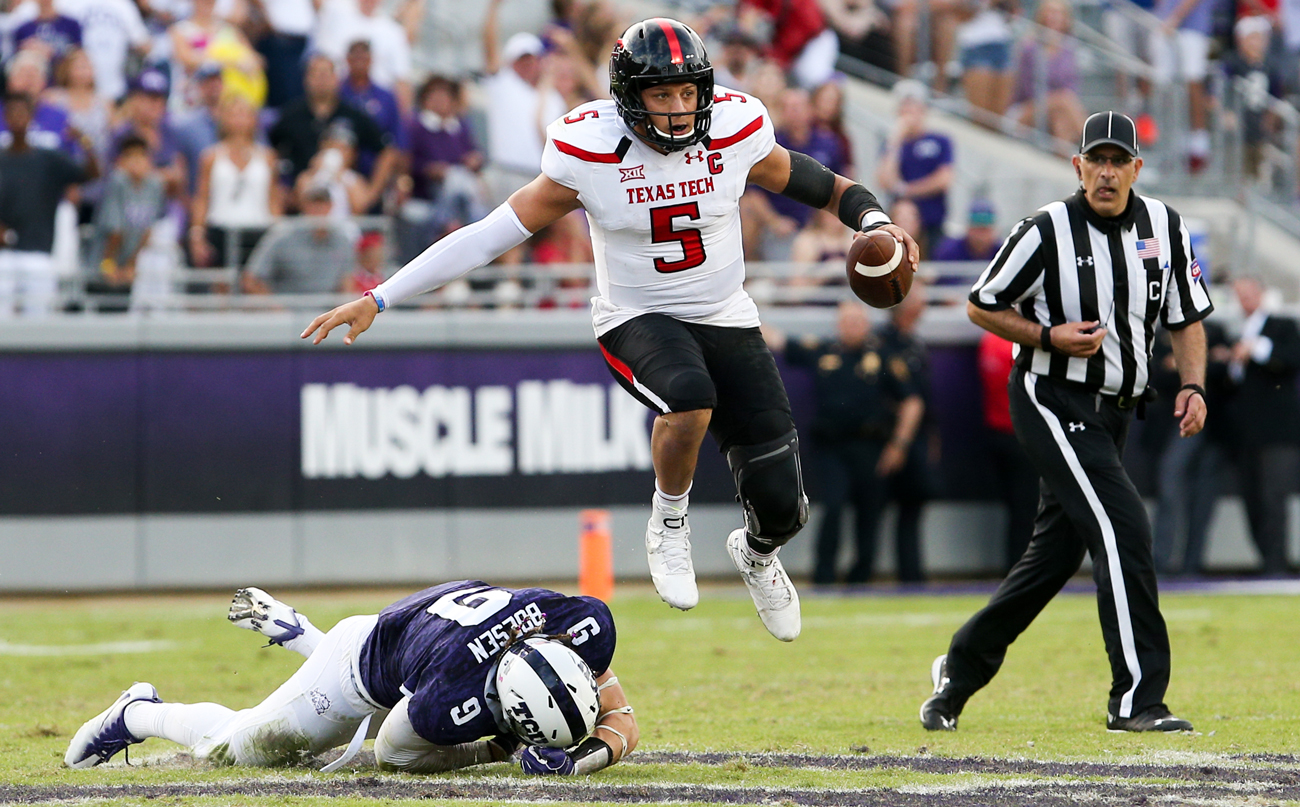
“I’m gonna guess it’s about growing up around sports,” says Schwartz, the Chiefs tackle. “When you’re in big-league locker rooms and taking lessons from Alex Rodriguez, you get numb to the fact that this is a different life. Some combination of that, and that natural ‘it’ factor we talk about with quarterbacks. Things slow down and make sense for him.”
“He was raised around baseball and was playing catch with Alex Rodriguez,” says Eric Morris, Mahomes’ offensive coordinator at Texas Tech, “so I always thought that probably helped him immensely. Nothing was ever too big for him. He was used to it. When he got in this environment he was never fazed.”
His father agrees: “I think that’s from him growing up in the clubhouse. He adopted the same mindset as some of the pro players,” Pat Mahomes says.
24 Hours ... With Patrick Mahomes
But mom says it’s not necessarily true. When Patrick was a young boy, too young to understand the magnitude of what his father had accomplished in pro sports, he never seemed to get too excited about anything. “It used to drive me nuts when he was little because I grew up in a small town and I didn’t get to travel and do a lot of things, but he did,” Randi says, “but he never got excited. Disney World, Yankee Stadium. He never got excited about it. I wanted him to be excited about things, but that’s not his personality. Careful what you wish for, because my other son gets excited enough for 20 people.”
Patrick was a somewhat introverted child from the start. He’d have friends over in elementary school and keep to himself, declining to play. His parents divorced when he was 11, in 2006, a year Randi describes as the most difficult of his life. Eventually he made a small group of friends through sports, and though they could have terrorized Tyler on weekends after football victories, they usually stayed clear of the party scene, according to Mahomes’ friends. When he arrived at Texas Tech, a year after Baker Mayfield made brief landfall there, the contrast was stark. Mayfield, who transferred to Oklahoma after one season, was boisterous and loud, leading with his mouth and backing it up with his arm. Mahomes was reserved, and let his arm do all the talking.
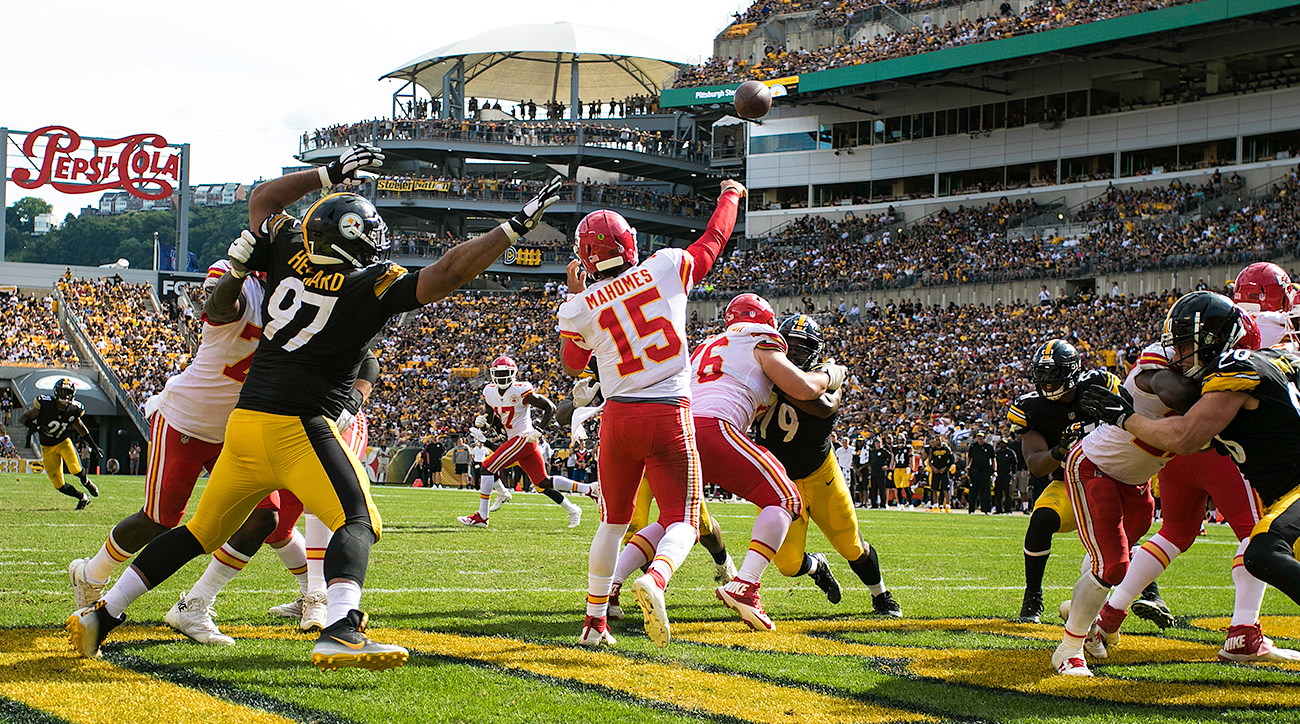
(When Mahomes did speak, his raspy voice became a source of amusement in the Texas Tech football program. Equipment manager Zane Perry nicknamed Mahomes, “Kermit the Frog.” Mahomes has always laughed it off, but his mother took umbrage when Reid this week described his voice as “froggish.” Said Ms. Mahomes: “Patrick thinks its funny, but as a mom I’m like, why’s he saying my son sounds like a frog? My sister would say you need to get that checked and I would say, ‘You need to worry about your own kid. I got this.’”).
“He's not one of those rah rah guys,” says former Texas Tech and current Miami Dolphins wide receiver Jakeem Grant. “But whenever he does talk everybody just shuts up and listens. He has that quiet-boy swag.”
THE MMQB NFL PODCAST: Four episodes each week, with the best NFL analysis and opinion. Subscribe on iTunes.
When Mahomes was drafted by the Chiefs, a team that already employed a veteran quarterback with starting chops and playoff experience, it was fair to wonder how the dynamic would play out. Would Smith turn his back on the rookie, and let him figure things out on his own? How would the rookie begin to command a locker room largely loyal to Smith if the two appeared at odds?
Thankfully for Mahomes, none of that came to bear. Smith, Reid says, wasn’t a tutor for Mahomes; that wasn’t his job. But he made himself available to Patrick at all times, and kept him abreast of his schedule. If Smith was coming in early to get a workout in before meetings, he let Patrick know, and Patrick followed. If Smith was planning on staying late to watch film, he let Mahomes know. “Alex was being Alex,” Reid says. “He left the door open for Patrick to join him. He just said, I’m gonna be here at this time, lifting, eating dinner, watching tape, watching more tape, studying the pictures of the game plan versus all the coverages and doing your own little doodles to figure it out. He gave that freely to Patrick, and that doesn’t always happen.
“That’s a big-ego position. The QB room can be a little snitty at times. But Patrick came into a great situation. Alex didn’t make any demands of him, but he didn’t close the door on him. Patrick can’t pay him enough for that opportunity.”
Spending a Season on the Bench Has Already Paid off for Chiefs QB Patrick Mahomes
Few could have blamed Smith if he’d felt inclined to sulk, or to ignore Mahomes, who had been chosen with the 10th pick in lieu of a number of worthy players at other positions. (The No. 11 pick of the draft, Saints cornerback Marshon Lattimore, established himself in 2017 as a premier talent, winning defensive rookie of the Year honors and a Pro Bowl nod.) But Smith just went about his business and had the best statistical season of his career, leading the Chiefs to 10-6 and the AFC West crown. After their first-round playoff loss to the Titans, Schwartz called Smith ”the best quarterback in the NFL this year.”
“I think in a general sense he’s underappreciated,” Schwartz told The MMQB then. “We really understand in our locker room how valuable he is to our offense, relative to other quarterbacks in the NFL.”
And if Smith were to be traded, and Mahomes named the starter? “If that were the case and Alex is out, we’d understand what we’re losing,” Schwartz said. “We know that Alex is really the driving force that makes the offense go.”
What Schwartz wasn’t saying, and what was growing apparent to many in the locker room over the course of the 2017 season, was that Mahomes was something of a freak. The prospect of him seeing live action was, at the very least, a subject of tremendous intrigue.
Justin Houston remembers watching the 2017 draft in Atlanta with friends, excited to see who Reid and Dorsey would add to Smith’s young cadre of playmakers, or perhaps to a defense that had seen better days. But the pick was Mahomes, the 6’4” quarterback from Texas Tech who’d never had better than a 7-6 season in his time as a Red Raider. However, a friend at the gathering assured Houston that Mahomes was a special talent. He sent Houston a video of Mahomes throwing a football 65 yards downfield while sprinting from the pocket.
“In all honesty I said, who the f--- is this? We traded up to get him?” Houston recalls. “We’ve got Alex at the time, and that was the last thing I thought we’d do. But we did, and God as my witness I’m so happy we did.
“I remember showing up for OTAs [that year] and he made a throw, and I knew right then he was special. He was rolling to his left and he hit this guy 30 yards down field on a crossing route. I was like, Oh yeah.”
In January 2018, the Chiefs dealt Smith to Washington for cornerback Kendall Fuller, promoting Mahomes to starter.
“I get it,” Houston says. “We’ve understood for a while now, that’s one in a million. He’s one of a kind.”
One struggles to find the perfect word to best describe the way the football leaves Patrick Mahomes’ right hand. Throw is too vague, and doesn’t quite capture the novelty of it. Fling describes the right amount of force but overstates the effort. Same goes for launch and chuck. Morris, the former Texas Tech offensive coordinator, probably puts it best: “You turn on the Texas Tech tape, and it’s just Patrick, running left, running right, flipping it 50 yards downfield to wide open guys.”
Flip. That’ll work.
That’s what Morris saw in the summer before Mahomes’ junior season in high school (the year he almost quit), when Texas Tech was recruiting prep track star K.D. Cannon at a summer camp. Cannon met Patrick Mahomes at the camp and asked him to throw nothing but ‘go’ balls in one-on-one scenarios. Rep after rep, Mahomes let fly a perfect deep ball without much ceremony or windup.
That performance put Mahomes, who had yet to start a game at quarterback at any level, on Texas Tech’s radar. It helped that Whitehouse High, under coach Adam Cook, had recently adopted the Air Raid offense, innovated by Hal Mumme and Mike Leach in the late 1980s beginning at Iowa Weslyan College. Practitioners include coaches Lincoln Riley, Kliff Kingsbury, Sonny Dykes, Dana Holgersen and Morris, who left Texas Tech after the 2017 season to lead the football team at Incarnate Word, an FCS program in San Antonio.
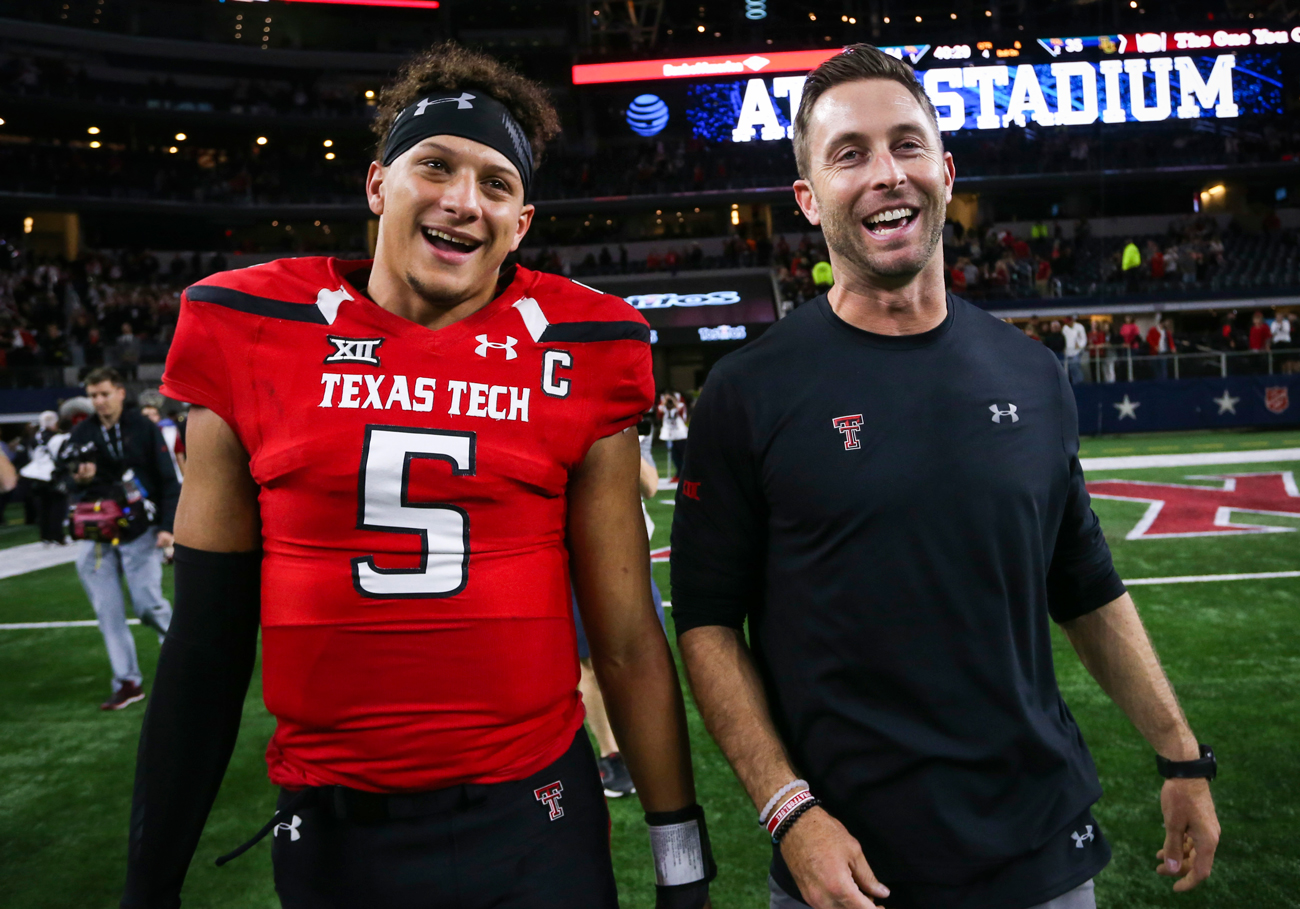
The offense, as Mumme and Leach pioneered it, was predicated on a quick passing game, big offensive line splits, no huddle, and freedom for either the coach or the quarterback to diagnose the defense pre-snap and audible to an appropriate play. For two decades, Air Raid quarterbacks fizzled out in the NFL. The top five QBs in NCAA passage yardage in history—Case Keenum, Timmy Chang, Landry Jones, Graham Harrell and Ty Detmer—are all Air Raid alumni. Those five combined have 72 NFL starts and zero Super Bowl appearances.
For one thing, the system never required a big arm for success, only the ability to make quick reads and release the ball just as fast. For another thing, Air Raid quarterbacks traditionally didn’t learn as much offensive football as their peers, given the system’s heavy reliance on the coach on the sideline. For yet another, NFL coaches were often unwilling to tailor offenses to quarterbacks versed in an offense that many thought couldn’t translate to the NFL
Says Mahomes: “You hear that sort of thing a lot, especially from analysts and media people. But NFL coaches figure out how much you really are controlling. I feel like with the Air Raid nowadays, it’s not so much signaling from the sideline. Now you signal to the quarterback and he makes the calls and signals to everybody else. It’s still a different degree of responsibility in the NFL, but at least you’ve had a responsibility to run an offense. Those guys like Harrell came along too early.
Patrick Mahomes Is Ready to Show Off His Fastball
“The NFL’s always adapting. We have more speed on the field now, things are more spread out, and things are being adjusted for quarterbacks who are accustomed to that. Coaches are saying, let’s get these playmakers the ball and let them run with it.”
Morris isn’t so sure that the first Air Raid QBs would be destined for success today: “Patrick wasn’t your typical Graham Harrell or Tim Couch [the 1999 No. 1 pick who played under Mumme at Kentucky],” he says. “His arm talent is so much better than those guys. I also think we really expanded on the Mike Leach system and really asked them to do a lot of different stuff, rather than running the same 30 plays over and over and over. Mike Leach is the only one still sticking to his roots and doing the true Air Raid stuff.”
Watch any Chiefs game this season, and you will see Air Raid passing concepts sprinkled throughout, but Andy Reid is quick to clarify that his plan for Mahomes did not include a reproduction of the Air Raid. It’s more complicated than that.
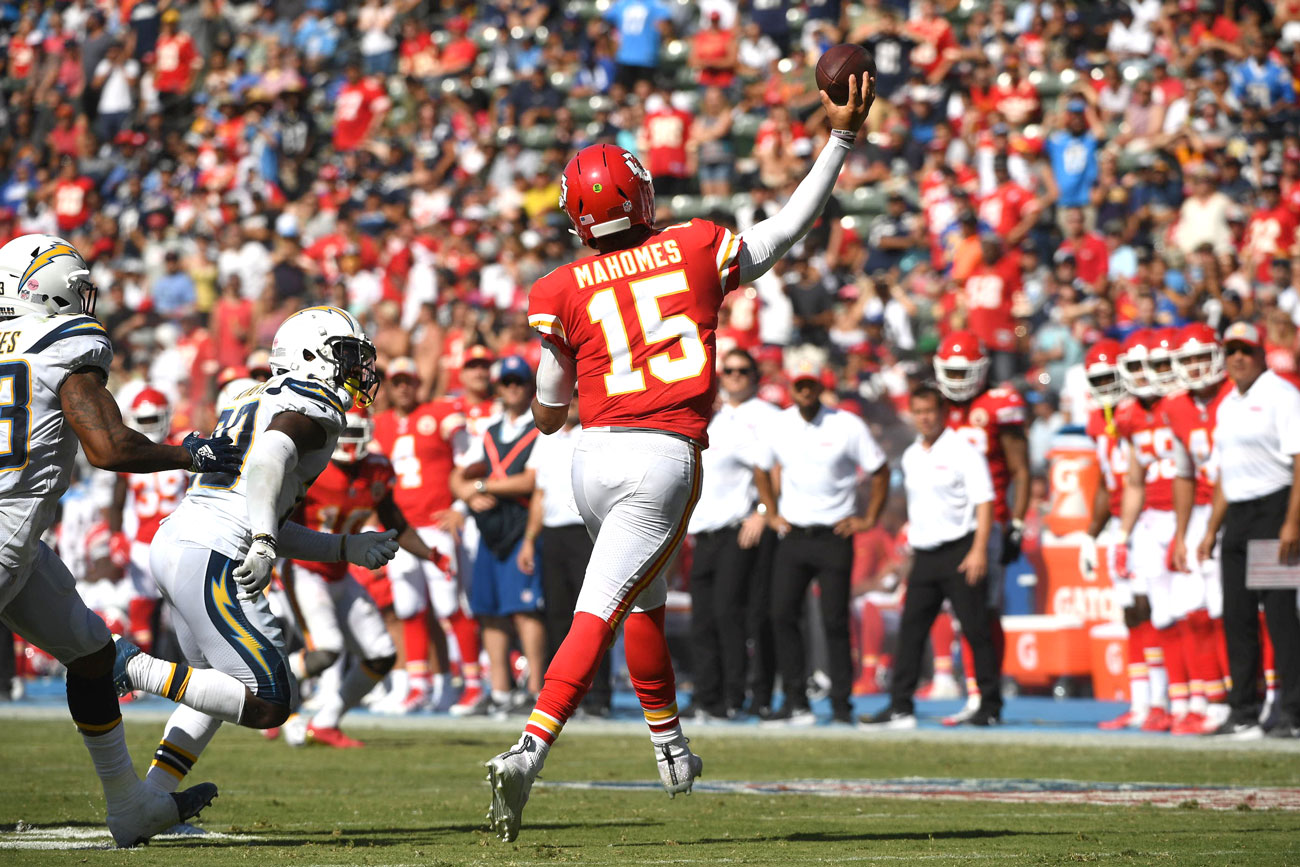
As with any football scheme that finds massive success in small doses—be it Walter Camp’s Full House backfield or Bum Phillips’ 3-4 defense—the chain of custody follows a basic trajectory. First it’s dismissed by the establishment as gadgetry, then it’s adopted by a secondary wave of innovators. It’s molded to fit personnel and changing rules and growing imaginations until it has dozens of iterations at every level. It’s at this point it either becomes a permanent or semi-permanent aspect of the game, or the opposing side figures it out, or rules change the way the game is played, and it disappears, sometimes as suddenly as it sprouted.
Individual plays pass through the hands of multiple coaches and programs and take on lives of their own, with a complex and at times indecipherable etymology. Take, for instance, a new staple of the Chiefs offense. In Super Bowl XLIX, in Arizona in February 2015, Bill Belichick’s Patriots ran a variation of an original Air Raid concept from the photocopied playbooks of Hal Mumme. The inside receiver runs a flat route to the sideline, and the outside receiver runs a slant, and the quarterback fakes a handoff, then decides between the two routes. At Texas Tech, Morris and Kingsbury liked the play call and thought to add a run-pass option element, where the quarterback has the option to hand off the ball. They installed the play for the 2016 season. A year later the Chiefs started running something similar; Reid says the inspiration came not from the Patriots, or from Texas Tech, but from Alex Smith’s experience at Utah in the early 2000s. When Mahomes took the reins in K.C., the play was handed to him. For his part, Mahomes had been running a variation of that same RPO since he was 16 years old. What Texas Tech called “Dragon,” Whitehouse High called “Cougar.”
“I think Kingsbury is brilliant,” Reid says, “and Patrick’s high school coach was probably smart with this stuff too. With RPOs, the ability to run the ball or throw the ball and still work your blocking assignments is so valuable. So we borrowed a couple things from that, but most of our offense is the same stuff we’ve been doing.”
Says Morris: “I think Patrick got lucky to have Andy Reid as a head coach who allows him to use his skill set.”
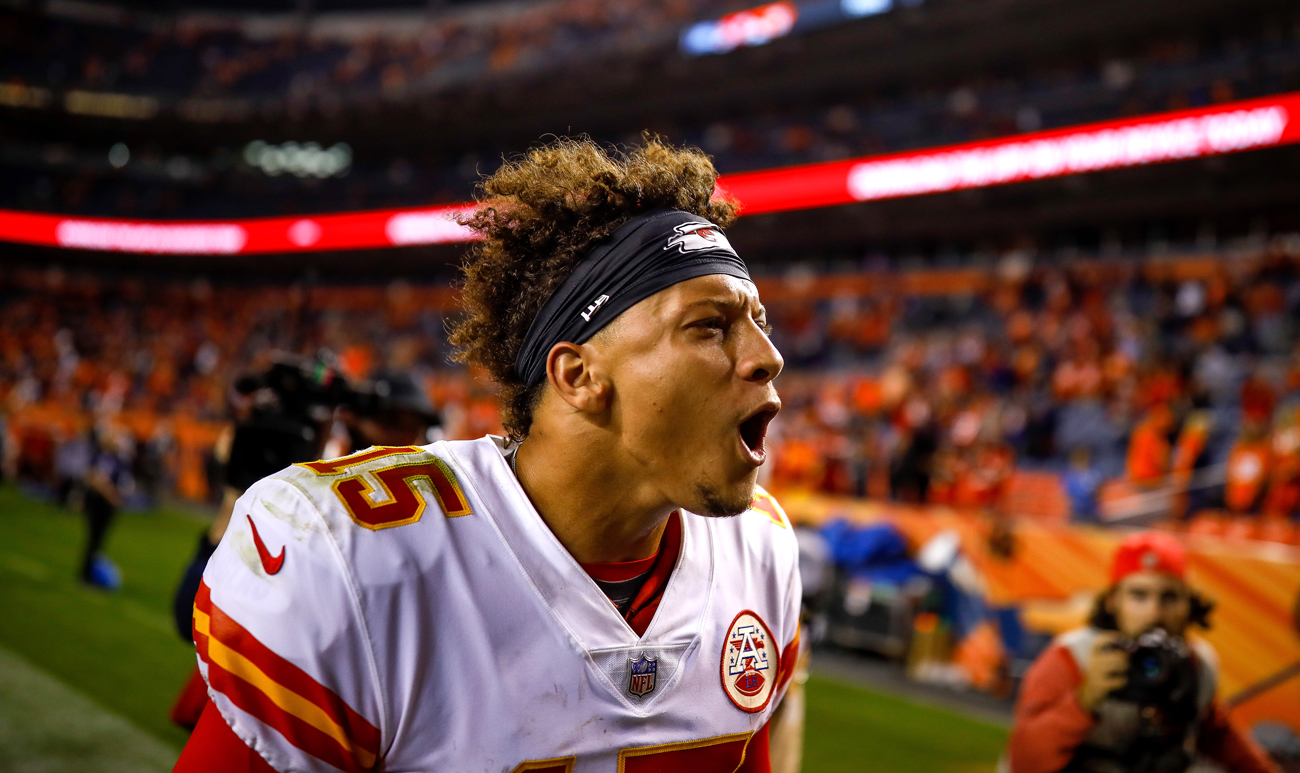
The chain of custody can be confusing, but the current key-holder is all alone at the top. Mahomes isn’t just a special talent—he’s one who landed in the exact right place at the exact right time. And to watch Mahomes freestyle, to see him buy time and make the throws you can’t teach, is to wonder what’s to come.
In fact, just in case you thought you saw it all, know this: Mahomes gave Reid his favorite play from Texas Tech, and the Chiefs have installed it but haven’t yet called it in a game.
“It’s probably something with max protection,” Morris says, “where he can get some time to step up in the pocket and just throw it deep.”
We’ll be watching.
Question or comment? Email us at talkback@themmqb.com.
